Asus 2015 Annual Report Download - page 248
Download and view the complete annual report
Please find page 248 of the 2015 Asus annual report below. You can navigate through the pages in the report by either clicking on the pages listed below, or by using the keyword search tool below to find specific information within the annual report.-
 1
1 -
 2
2 -
 3
3 -
 4
4 -
 5
5 -
 6
6 -
 7
7 -
 8
8 -
 9
9 -
 10
10 -
 11
11 -
 12
12 -
 13
13 -
 14
14 -
 15
15 -
 16
16 -
 17
17 -
 18
18 -
 19
19 -
 20
20 -
 21
21 -
 22
22 -
 23
23 -
 24
24 -
 25
25 -
 26
26 -
 27
27 -
 28
28 -
 29
29 -
 30
30 -
 31
31 -
 32
32 -
 33
33 -
 34
34 -
 35
35 -
 36
36 -
 37
37 -
 38
38 -
 39
39 -
 40
40 -
 41
41 -
 42
42 -
 43
43 -
 44
44 -
 45
45 -
 46
46 -
 47
47 -
 48
48 -
 49
49 -
 50
50 -
 51
51 -
 52
52 -
 53
53 -
 54
54 -
 55
55 -
 56
56 -
 57
57 -
 58
58 -
 59
59 -
 60
60 -
 61
61 -
 62
62 -
 63
63 -
 64
64 -
 65
65 -
 66
66 -
 67
67 -
 68
68 -
 69
69 -
 70
70 -
 71
71 -
 72
72 -
 73
73 -
 74
74 -
 75
75 -
 76
76 -
 77
77 -
 78
78 -
 79
79 -
 80
80 -
 81
81 -
 82
82 -
 83
83 -
 84
84 -
 85
85 -
 86
86 -
 87
87 -
 88
88 -
 89
89 -
 90
90 -
 91
91 -
 92
92 -
 93
93 -
 94
94 -
 95
95 -
 96
96 -
 97
97 -
 98
98 -
 99
99 -
 100
100 -
 101
101 -
 102
102 -
 103
103 -
 104
104 -
 105
105 -
 106
106 -
 107
107 -
 108
108 -
 109
109 -
 110
110 -
 111
111 -
 112
112 -
 113
113 -
 114
114 -
 115
115 -
 116
116 -
 117
117 -
 118
118 -
 119
119 -
 120
120 -
 121
121 -
 122
122 -
 123
123 -
 124
124 -
 125
125 -
 126
126 -
 127
127 -
 128
128 -
 129
129 -
 130
130 -
 131
131 -
 132
132 -
 133
133 -
 134
134 -
 135
135 -
 136
136 -
 137
137 -
 138
138 -
 139
139 -
 140
140 -
 141
141 -
 142
142 -
 143
143 -
 144
144 -
 145
145 -
 146
146 -
 147
147 -
 148
148 -
 149
149 -
 150
150 -
 151
151 -
 152
152 -
 153
153 -
 154
154 -
 155
155 -
 156
156 -
 157
157 -
 158
158 -
 159
159 -
 160
160 -
 161
161 -
 162
162 -
 163
163 -
 164
164 -
 165
165 -
 166
166 -
 167
167 -
 168
168 -
 169
169 -
 170
170 -
 171
171 -
 172
172 -
 173
173 -
 174
174 -
 175
175 -
 176
176 -
 177
177 -
 178
178 -
 179
179 -
 180
180 -
 181
181 -
 182
182 -
 183
183 -
 184
184 -
 185
185 -
 186
186 -
 187
187 -
 188
188 -
 189
189 -
 190
190 -
 191
191 -
 192
192 -
 193
193 -
 194
194 -
 195
195 -
 196
196 -
 197
197 -
 198
198 -
 199
199 -
 200
200 -
 201
201 -
 202
202 -
 203
203 -
 204
204 -
 205
205 -
 206
206 -
 207
207 -
 208
208 -
 209
209 -
 210
210 -
 211
211 -
 212
212 -
 213
213 -
 214
214 -
 215
215 -
 216
216 -
 217
217 -
 218
218 -
 219
219 -
 220
220 -
 221
221 -
 222
222 -
 223
223 -
 224
224 -
 225
225 -
 226
226 -
 227
227 -
 228
228 -
 229
229 -
 230
230 -
 231
231 -
 232
232 -
 233
233 -
 234
234 -
 235
235 -
 236
236 -
 237
237 -
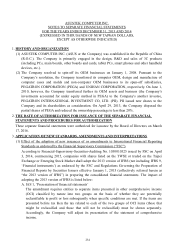 238
238 -
 239
239 -
 240
240 -
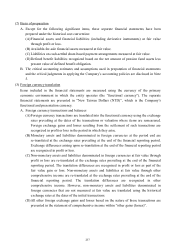 241
241 -
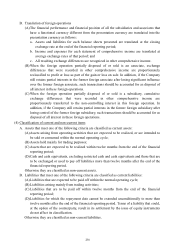 242
242 -
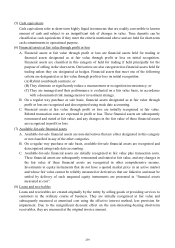 243
243 -
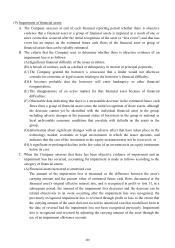 244
244 -
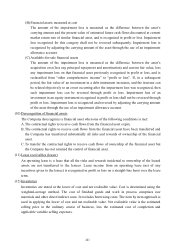 245
245 -
 246
246 -
 247
247 -
 248
248 -
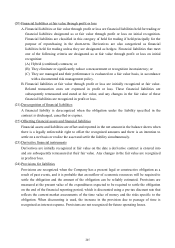 249
249 -
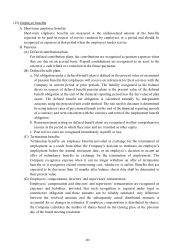 250
250 -
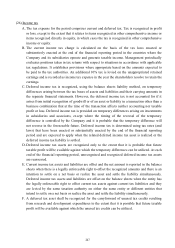 251
251 -
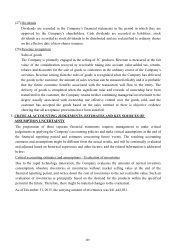 252
252 -
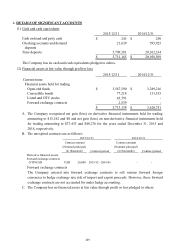 253
253 -
 254
254 -
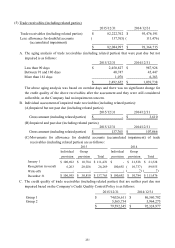 255
255 -
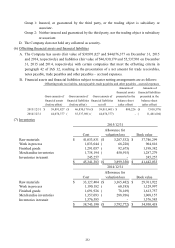 256
256 -
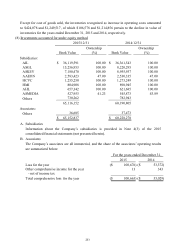 257
257 -
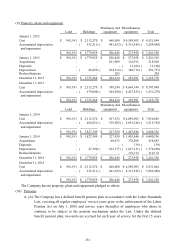 258
258 -
 259
259 -
 260
260 -
 261
261 -
 262
262 -
 263
263 -
 264
264 -
 265
265 -
 266
266 -
 267
267 -
 268
268 -
 269
269 -
 270
270 -
 271
271 -
 272
272 -
 273
273 -
 274
274 -
 275
275 -
 276
276 -
 277
277 -
 278
278 -
 279
279
 |
 |

244
D. The assets’ residual values, useful lives and depreciation methods are reviewed, and adjusted if
appropriate, at each end of the financial reporting period. If expectations for the assets’ residual
values and useful lives differ from previous estimates or the patterns of consumption of the
assets’ future economic benefits embodied in the assets have changed significantly, any change
is accounted for as a change in estimate under IAS 8, “Accounting Policies, Changes in
Accounting Estimates and Errors”, from the date of the change. The estimated useful lives of
the buildings are 10~50 years, machinery and equipment are 3 years and miscellaneous
equipment are 1~15 years.
(15) Leased assets (lessee)
An operating lease is a lease that the lessor assumes substantially all the risks and rewards
incidental to ownership of the leased asset. Payments made under an operating lease (net of any
incentives received from the lessor) are recognized in profit or loss on a straight-line basis over
the lease term.
(16) Investment property
An investment property is stated initially at its cost and measured subsequently using the cost
model. Except for land, investment property is depreciated on a straight-line basis over its
estimated useful life of 50 years.
(17) Intangible assets
Computer software is amortised on a straight-line basis over its estimated useful life of 1~5 years.
(18) Impairment of non-financial assets
A. The Company assesses at each end of the financial reporting period the recoverable amounts of
those assets where there is an indication that they are impaired. An impairment loss is
recognized for the amount by which the asset’s carrying amount exceeds its recoverable
amount. The recoverable amount is the higher of an asset’s fair value less costs to sell or value
in use. Except for goodwill, when the circumstances or reasons for recognizing impairment loss
for an asset in prior years no longer exist or decrease, the impairment loss shall be reversed to
the extent of the loss previously recognized in profit or loss. However, the reversal should not
exceed the carrying amount, net of depreciation or amortisation had the impairment not been
recognized.
B. The recoverable amounts of goodwill shall be evaluated periodically. An impairment loss is
recognized for the amount by which the asset’s carrying amount exceeds its recoverable
amount. Impairment loss of goodwill previously recognized in profit or loss shall not be
reversed in the following years.
(19) Notes and trade payables
Notes and trade payables are obligations to pay for goods or services that have been acquired from
suppliers in the ordinary course of business. They are recognized initially at fair value and
subsequently measured at amortised cost using the effective interest method. Due to the
insignificant discount effect on the non-interesting bearing short-term payables, they are measured
at the original invoice amount.
